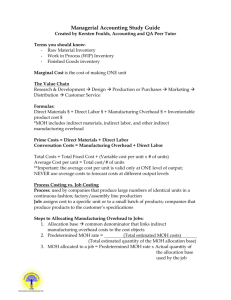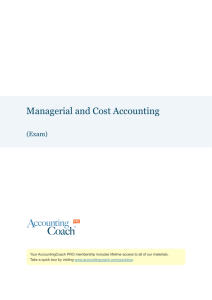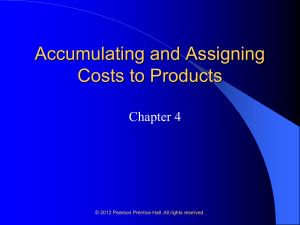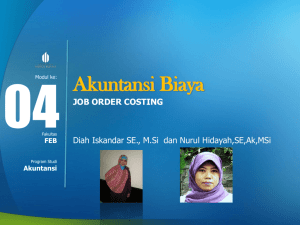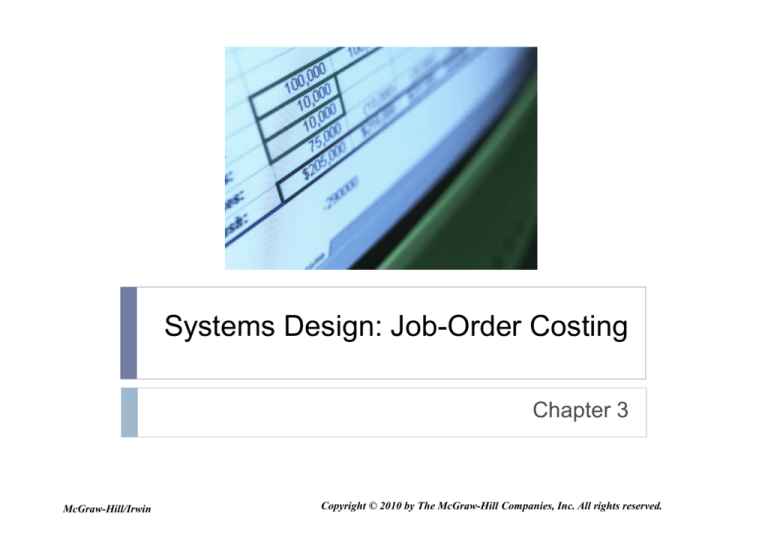
Systems Design: Job-Order Costing
Chapter 3
McGraw-Hill/Irwin
Copyright © 2010 by The McGraw-Hill Companies, Inc. All rights reserved.
Types of Product Costing Systems
Process
Costing
Job-order
Costing
Many different products are produced each period.
Products are manufactured to order.
The unique nature of each order requires tracing or
allocating costs to each job, and maintaining cost
records for each job.
3-2
Comparing Process and Job-Order Costing
Job-Order
Number of jobs worked
Cost accumulated by
Average cost computed by
Process
Many
Individual
Job
Single Product
Job
Department
Department
3-3
Measuring Direct Materials Cost
3-4
Job-Order Cost Accounting
3-5
Manufacturing Overhead Application
The predetermined overhead rate (POHR) used to
apply overhead to jobs is determined before the
period begins.
POHR =
Estimated total manufacturing
overhead cost for the coming period
Estimated total units in the
allocation base for the coming period
Ideally, the allocation base
is a cost driver that causes
overhead.
3-6
Determining Predetermined Overhead Rates
Predetermined overhead rates are calculated
using a three-step process.
Estimate the level of
production for the
period.
Estimate total amount
of the allocation base
for the period.
Estimate total
manufacturing
overhead costs.
POHR = ÷
3-7
Job-Order Cost Accounting
3-8
Job-Order Costing
Document Flow Summary
Materials
used may be
either direct or
indirect.
Direct
materials
Job Cost
Sheets
Materials
Requisition
Indirect
materials
Manufacturing
Overhead
Account
3-9
Job-Order Costing
Document Flow Summary
An
employee’s
time may be either
direct or
indirect.
Direct
Labor
Job Cost
Sheets
Employee Time
Ticket
Indirect
Labor
Manufacturing
Overhead
Account
3-10
Job-Order Costing
Document Flow Summary
Materials
Requisition
Other
Actual OH
Charges
Employee
Time Ticket
Indirect
Material
Manufacturing
Overhead
Account
POHR
rate used
to apply
overhead
Job Cost
Sheets
Indirect
Labor
3-11
The Purchase and Issue of Raw Materials
Raw Materials
Material Direct
Purchases Materials
Indirect
Materials
Work in Process
(Job Cost Sheet)
Direct
Materials
Mfg. Overhead
Actual Applied
Indirect
Materials
3-12
Cost Flows – Material Purchases
Raw material purchases are recorded in an
inventory account.
3-13
Cost Flows – Material Usage
Direct materials issued to a job increase Work in
Process and decrease Raw Materials. Indirect
materials used are charged to Manufacturing
Overhead and also decrease Raw Materials.
3-14
The Recording of Labor Costs
Salaries and
Wages Payable
Direct
Labor
Indirect
Labor
Work in Process
(Job Cost Sheet)
Direct
Materials
Direct
Labor
Mfg. Overhead
Actual
Indirect
Materials
Indirect
Labor
Applied
3-15
Applying Manufacturing Overhead
Salaries and
Wages Payable
Direct
Labor
Indirect
Labor
Mfg. Overhead
Actual Applied
Indirect
Materials Overhead
Indirect
Applied to
Labor
Work in
Other
Process
Overhead
Work in Process
(Job Cost Sheet)
Direct
Materials
Direct
Labor
Overhead
Applied
If actual and applied
manufacturing overhead
are not equal, a year-end
adjustment is required.
3-16
Transferring Completed Units
Work in Process
(Job Cost Sheet )
Direct
Materials
Direct
Labor
Overhead
Applied
Finished Goods
Cost of
Goods
Mfd.
Cost of
Goods
Mfd.
3-17
End of Chapter 3
3-18


